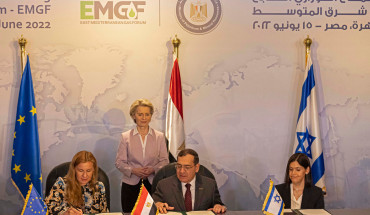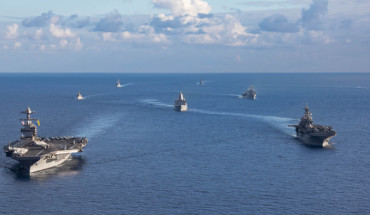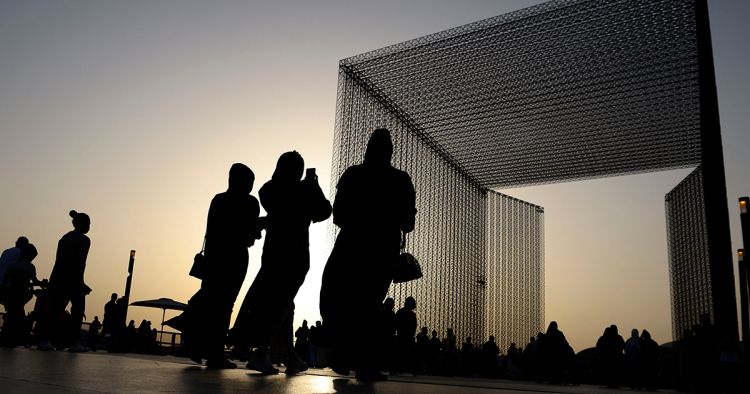The Gulf states emerged from the global pandemic with the wind in their economic sails. Higher energy prices meant reasonable prospects of balanced budgets and surpluses after 2020’s unprecedented collapse in demand for hydrocarbons.
The ongoing draw of the United Arab Emirates was bolstered by its successful handling of the pandemic, new residency laws, a World Expo event, and a European conflict that prompted an influx of high-net-worth economic migrants. Saudi Arabia plowed on with its Vision 2030 ambitions and Qatar made history as the first ever Arab country to host a FIFA World Cup.
You would be forgiven for thinking things couldn’t be better; however, these spectacular events continued to mask two subtle but major weaknesses that have plagued the Gulf states for decades. These are revealed by asking two increasingly important questions: Why do Gulf economies lack innovation? And why do they struggle to create private sector employment for nationals?
The dawn of modernity
To answer these questions, one must paint a picture of the Gulf as it entered the 1900s, a geography that lacked even the most basic infrastructure. Expanses of barren desert were interrupted only by the highly saline waters of the Arabian Gulf. Along the pristine coastlines were occasional, very modest docks and marinas, home to wooden boats that provided many members of the local merchant class, known as the Tijjar, with income from fishing, pearling, and trading between India, Africa, and Persia. This remains within living memory of today’s eldest Khaleeji generation.
As oil production in these young nations commenced, it gave them the capacity for transformational infrastructure development. On blank slates, the construction of power plants, roads, hospitals, schools, post offices, and airports began in earnest. The Gulf was practically unparalleled in the pace at which it urbanized.
In this post-colonial era the development of not just infrastructure but the institutions that managed it further solidified the legitimacy of the ruling class. The emerging state bureaucracy was fashioned with limited introspection or critical thought. A new apparatus of government was layered upon antiquated hierarchical foundations, giving rise to “modern” Arab states that were a marriage of imperialism and patriarchal dogma. This phenomenon and its impact were described extensively by the late Hisham Sharabi in the 1980s, in what he termed "Neopatriarchy."
This latest incarnation of the patronage system favored two segments of Gulf national society but in a highly skewed manner. The Tijjar sat at the top of the distribution pyramid, just under the ruling class, with the rest of the population offered a diluted yet equally addictive form of participation, that of lifetime public sector employment and an expansive social welfare system.
This development model was eagerly facilitated by the commercial acumen of many of the existing Tijjar, thrilled at the prospect of replacing dhows and modest dwellings with air-conditioned cars and property portfolios in Europe. In doing so, the Gulf embraced modernity and certainly prosperity, but failed to develop a productive and sustainable socioeconomic framework.
Protectionism and the emergence of oligopolies
The Gulf states consequently facilitated what is called regulatory capture. This is when a political entity, policymaker, or regulator is co-opted to serve the commercial, ideological, or political interests of a minor constituency. In this case it was the Tijjar, who were the dominant economic force in the pre-oil era, and in many cases were significantly wealthier than the ruling families.
Two primary and extremely protectionist measures were conceived of by governments at this time, partly to limit capital leakage, but also, more importantly, to placate the Tijjar, reinforce the patronage system, and cement sovereignty as the region grappled with its post-colonial identity.
The first measure required that branded foreign goods and services only be distributed within a Gulf state through a local agent. These became known as agency laws, or Wakala. As domestic purchasing power increased, in line with hydrocarbon revenues, local agents exploited their sole-distributor status to leapfrog beyond spices and dates to secure exclusivity with higher-value items, such as industrial machinery and consumer goods. It is no wonder that many of the Gulf’s wealthiest business families trace their paths to fortune to the agencies of automobile dealerships.
The second protectionist measure, the Kafala system, emerged in the 1950s around the importation and employment of expatriate labor. New laws mandated that a Gulf national, or company, act as the sponsor, or Kafeel, of foreign labor. This allowed local sponsors to capture a significant share of the income derived from the output of low-cost imported labor.
While both systems were initially successful at stimulating a nascent domestic private sector economy and controlling the influx of foreign labor, they also introduced what would eventually become structural economic and social distortions that handicapped the region.
Economic concentration and anti-competition
In economic terms, what emerged was a massively corrupt form of capitalism, one that focused almost exclusively on oligopolistic trading, protected by law, and financed by waves of public sector expenditure. “In the Arab world, capitalism, introduced … in the nineteenth and early twentieth centuries, far from providing the conditions for the development of autonomous capitalism, produced the political and economic conditions of distorted, dependent capitalism,” Sharabi wrote in his 1988 book Neopatriarchy.
A lack of competition ensured trading offered a healthy and reliable return on capital. The attractiveness of trading meant less need or incentive to develop domestic production — as well as the accompanying economic sophistication it would have demanded. For nearly a century, this fostered an economic culture of private sector rent-seeking.
The tsunami of private sector capital formation that followed accrued to a minority of the population. The growing power and influence of the merchant class was, in turn, used to perpetuate and reinforce regulatory capture.
These two dominant and structural features of Gulf private sectors gave rise to an equal number of oligopolistic and rentier business models: an exclusive end-point of sale for goods and services (Wakala) and an equally exclusive right to arbitrage the price of imported labor (Kafala). A direct consequence of this was a chronic lack of competition and innovation, resulting in superficial development.
It’s important to highlight the role of the state in this process. As the largest source of final demand in Gulf countries, the state was the financial enabler of this symbiotic arrangement. Public sector spending for all manner of infrastructure and services became the artery that trading businesses depended on. Even household consumption was ultimately a function of generous state salaries distributed through an ever-expanding bureaucracy. The implicit social contract in places like Kuwait ensured generous personal incomes for life, but also inelastic demand for imported goods and services, enriching those with a coveted intermediary status.
A captive source of demand and a protected local market thus failed to create incentives for the private sector to be dynamic, let alone globally competitive. This meant that for decades, economic activity never evolved to become "productive" in an intellectual property and knowledge-building sense. “Possessing all the external trappings of modernity, this society nevertheless lacks the inner force, organization, and consciousness which characterize truly modern formations,” Sharabi wrote. Private sectors, far from developing an intellectual capacity and independence, instead grew under new protective legislation as mere extensions of the existing patronage system.
Today Gulf private sectors lack the capacity to critically analyze and solve problems. Instead, solutions are imported and sold, skirting the acquisition of knowledge implicit in the goods purveyed.
Successful development models become obsolete
This is not to say that this development model did not raise the standard of living of all residents across the Gulf, but that the prevailing conditions have long since changed. Eric Levitz’s comments on China apply equally well to the Gulf: “The trouble with a very successful development model is that, by definition, it resolves the problems it was created to address. A good development model renders itself obsolete. And yet, if such a model eliminates its animating purpose, it does not eliminate the interest groups who’ve come to benefit from it.”
Although the need to redefine the Gulf’s development model arose decades ago, change finally appears to be arriving. Agency laws have been drastically rewritten in the UAE. Longer tenure and more inclusive work visas have also been introduced. The private sector’s role in the political economy is being forced to change as well, in part as the expectant provider of employment specifically for nationals, in the UAE, Saudi Arabia, and the other Gulf states.
This is happening at a time when the competitive landscape is undergoing change on several fronts as local markets are liberalized, long-standing protections are removed, a variety of taxes are taking effect, and aggressive national hiring quotas are enforced. In most cases the process has been by diktat, with limited scope for negotiation thinly veiling a signal to the Tijjar that “you’ve had your time.”
However, a recalibration of the private sector’s role in Gulf economies, while necessary, obfuscates a much deeper-rooted set of constructs that are unlikely to change. Thinkers are increasingly asking the unanswered existential question: What does it mean to be a modern Arab Gulf society? The answer to that question can only be arrived at through the tumult of open dialogue and debate. In the meantime, policymakers prefer to focus on the symptoms, avoiding the equally existential risk in addressing the genesis of the region’s problems.
Ali Al-Salim is a Kuwaiti national with a background that spans 20 years in finance and technology. Ali is an active investor in Gulf and international financial markets, and the co-founder of Arkan Partners, a specialist consulting firm dedicated to alternative investments and Middle East investors. He can be followed on Twitter @alialsalim.
Photo by KARIM SAHIB/AFP via Getty Images
The Middle East Institute (MEI) is an independent, non-partisan, non-for-profit, educational organization. It does not engage in advocacy and its scholars’ opinions are their own. MEI welcomes financial donations, but retains sole editorial control over its work and its publications reflect only the authors’ views. For a listing of MEI donors, please click here.













